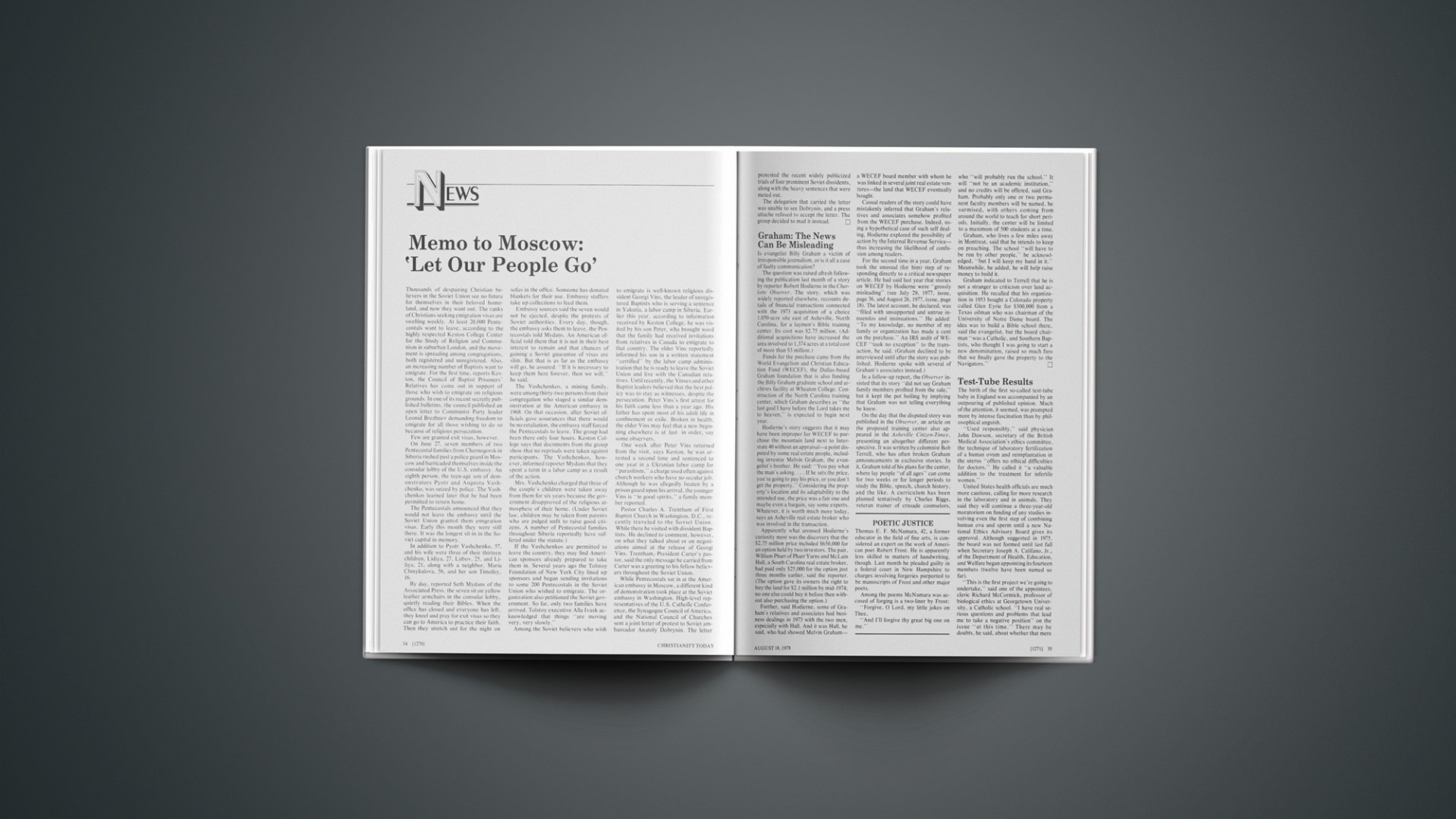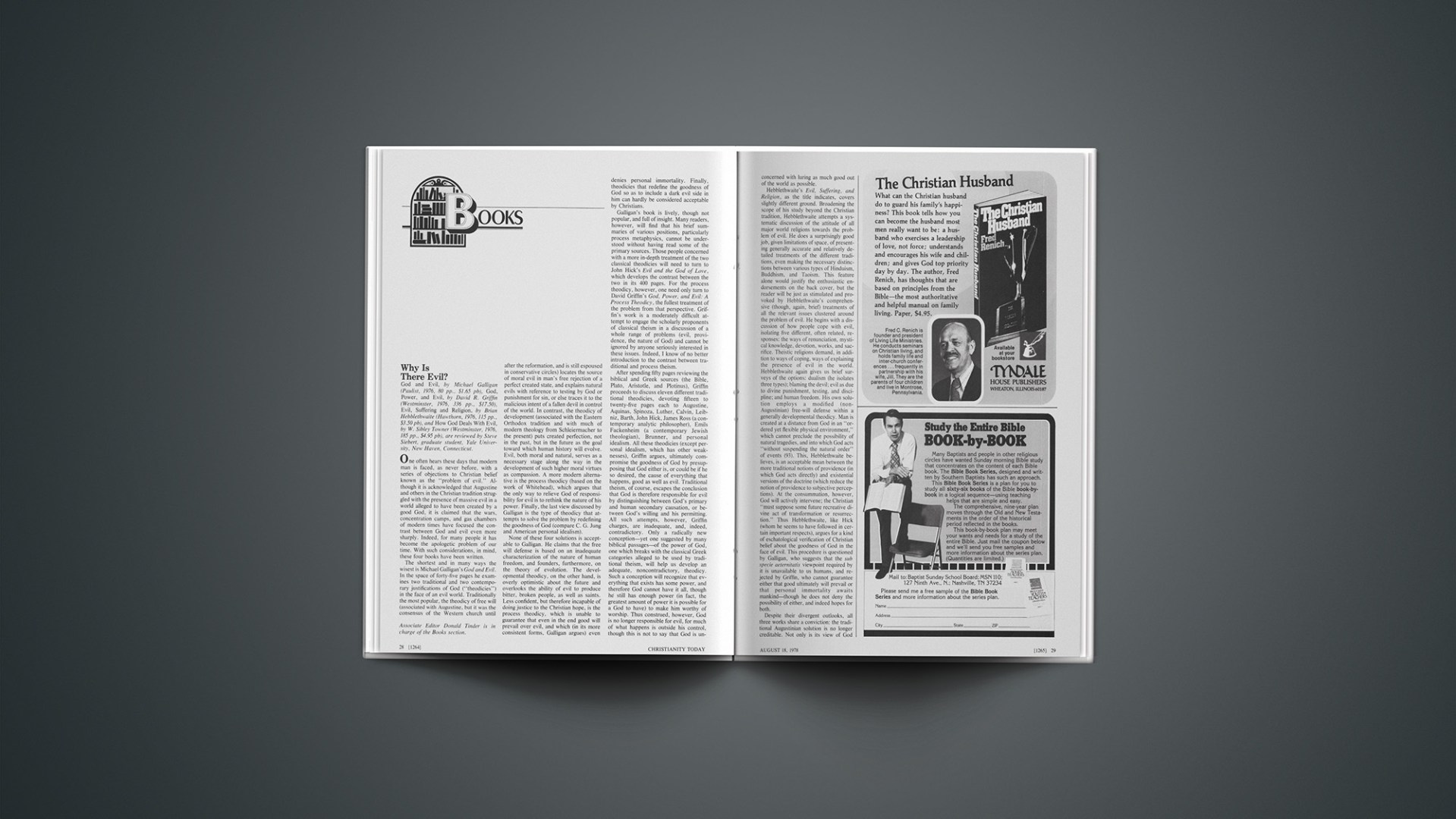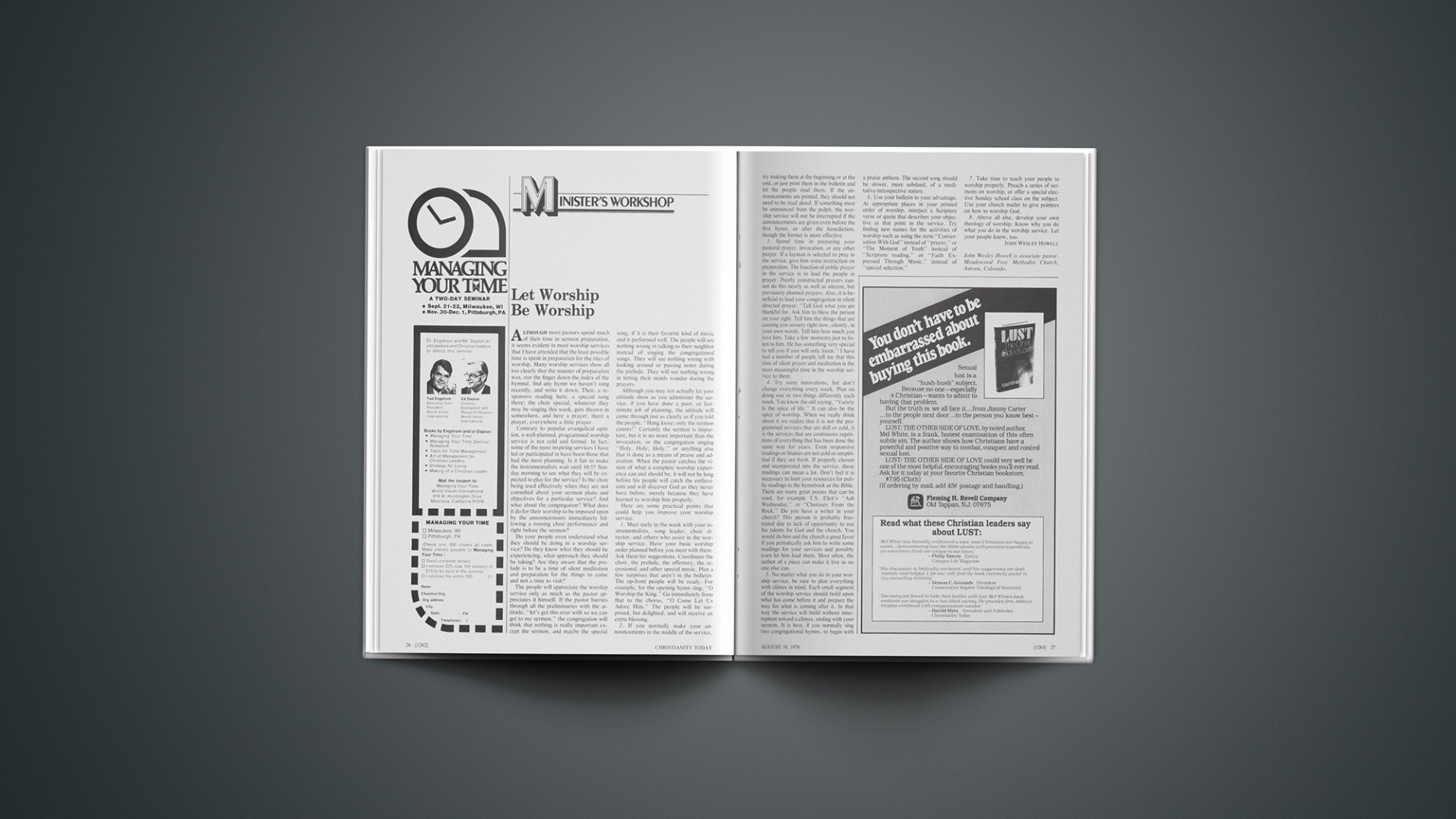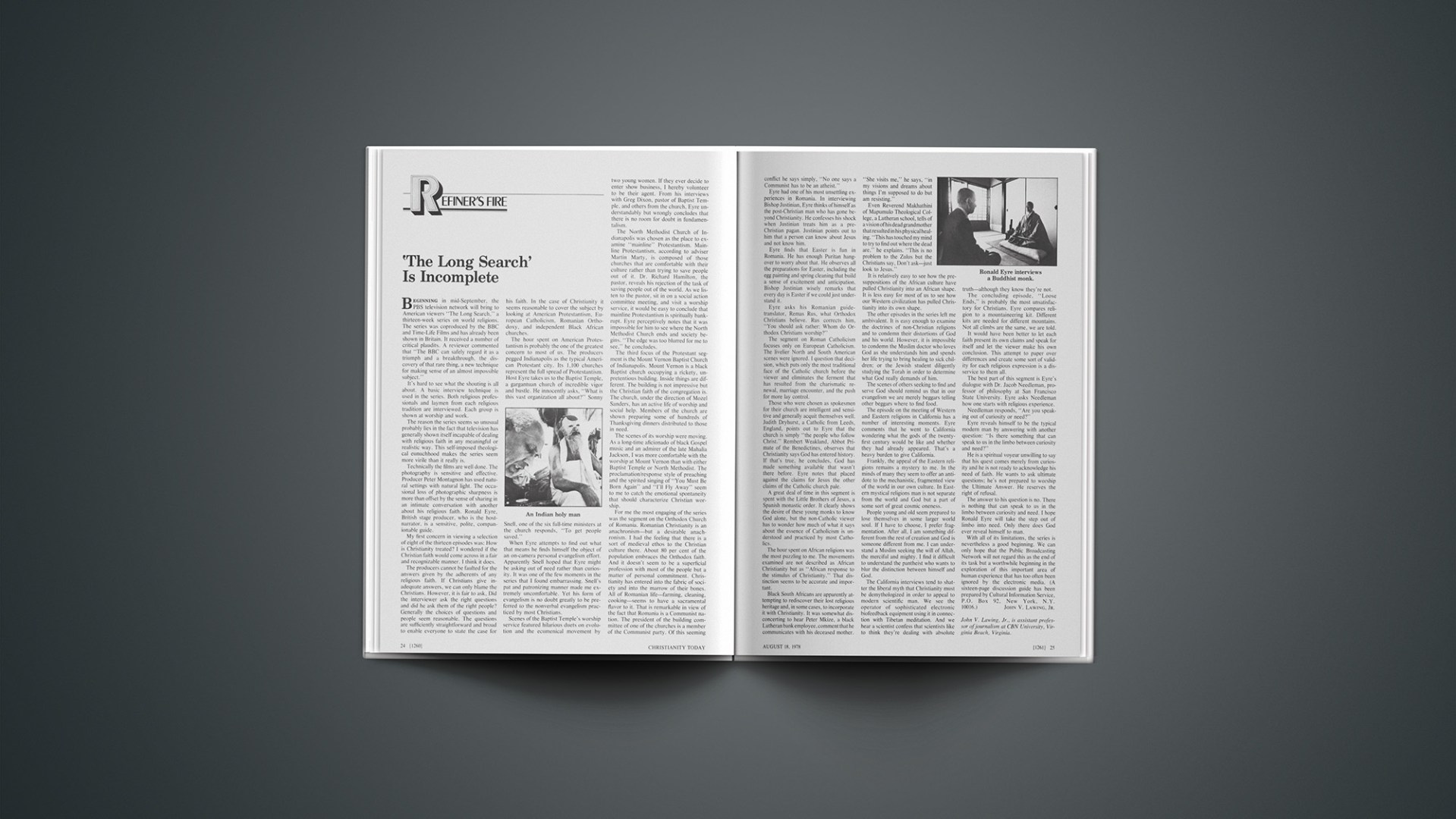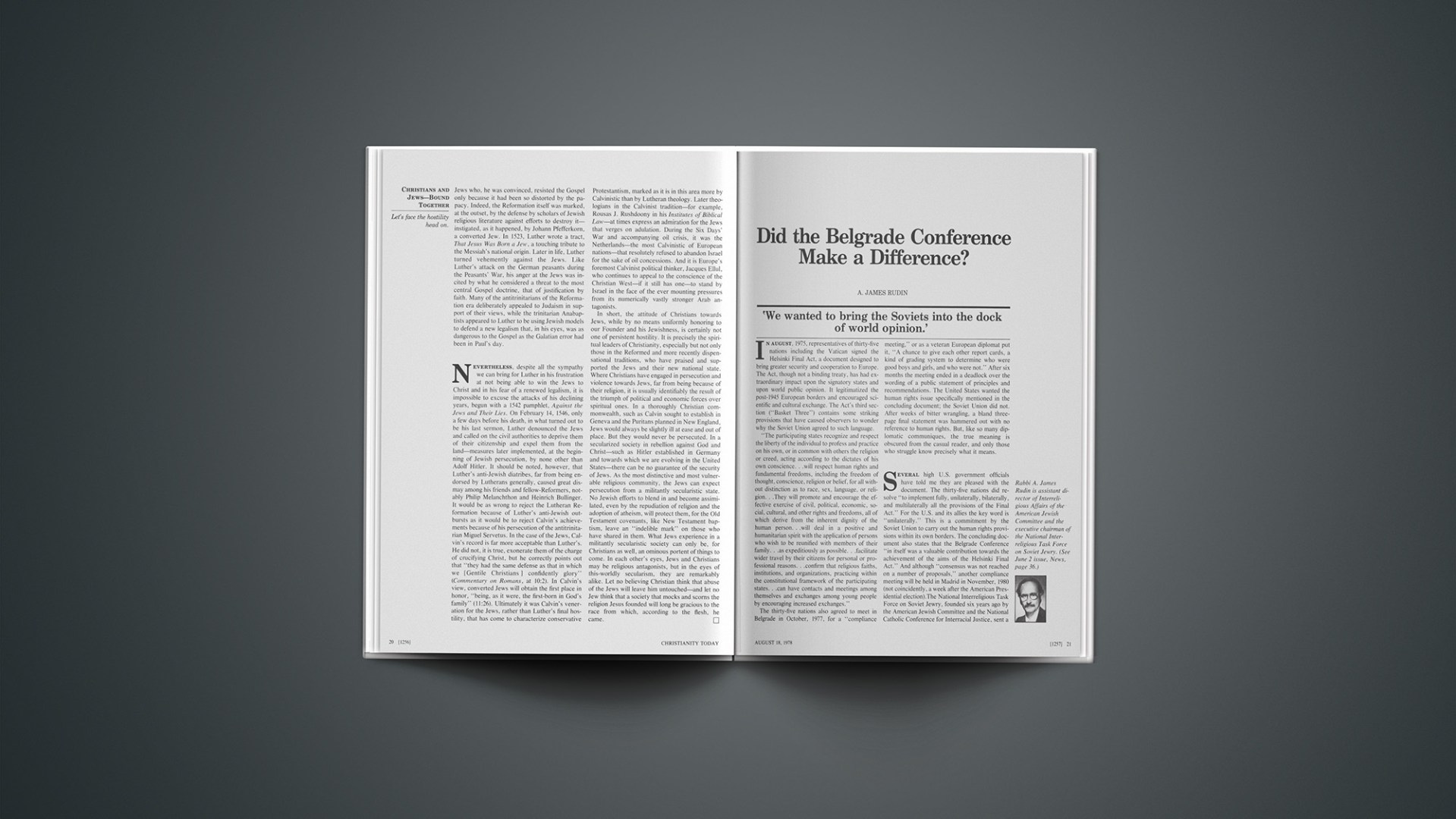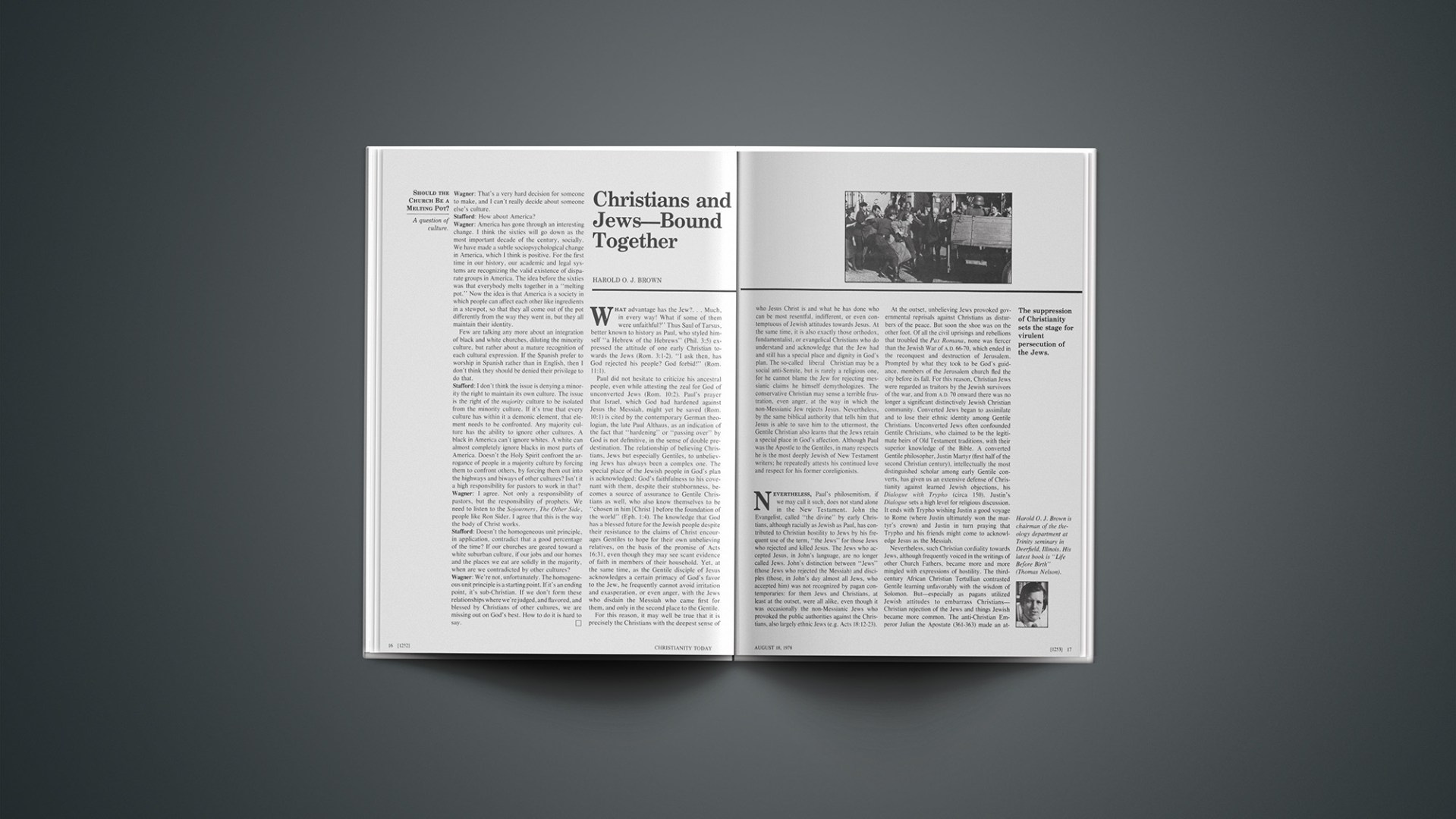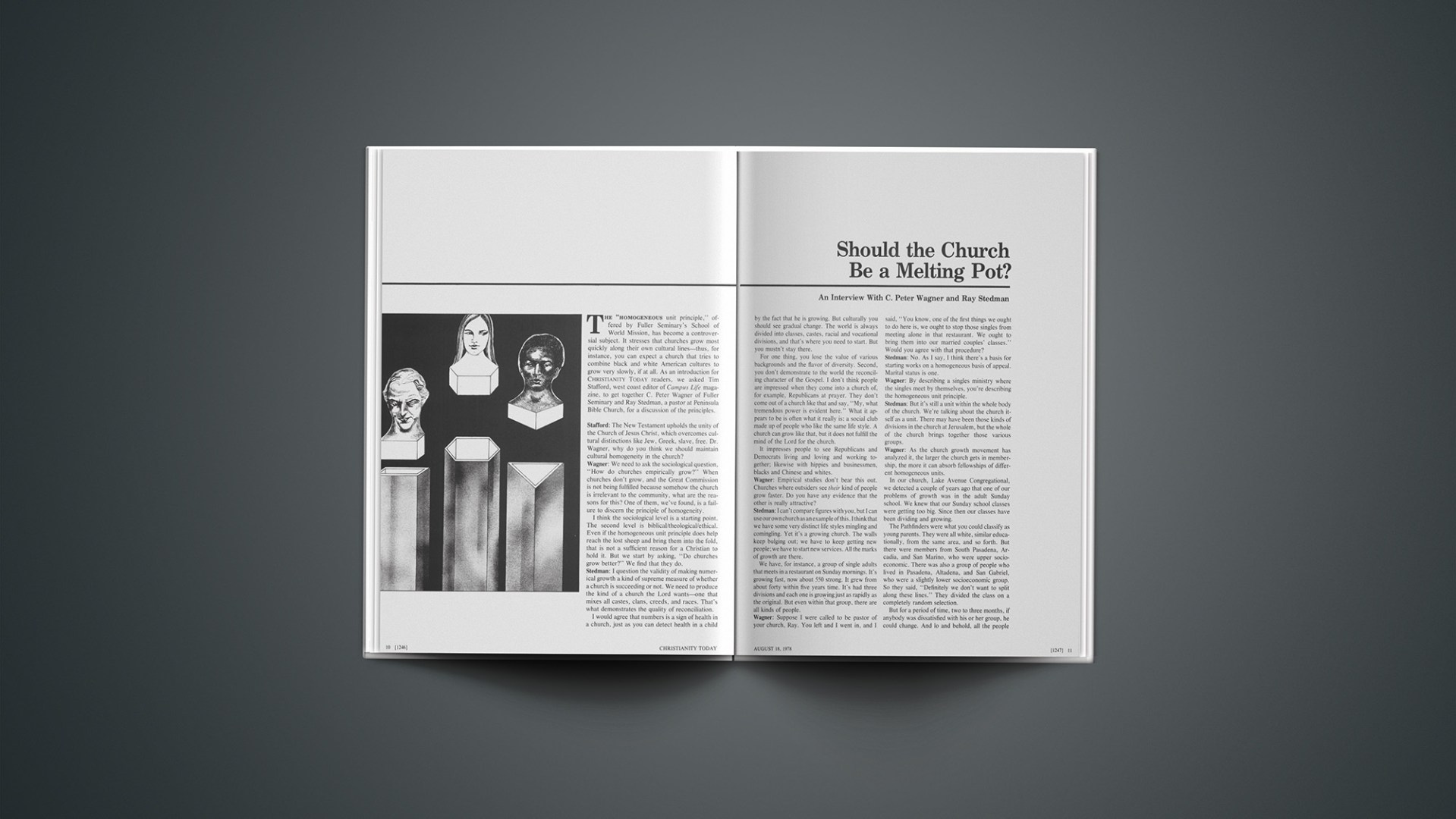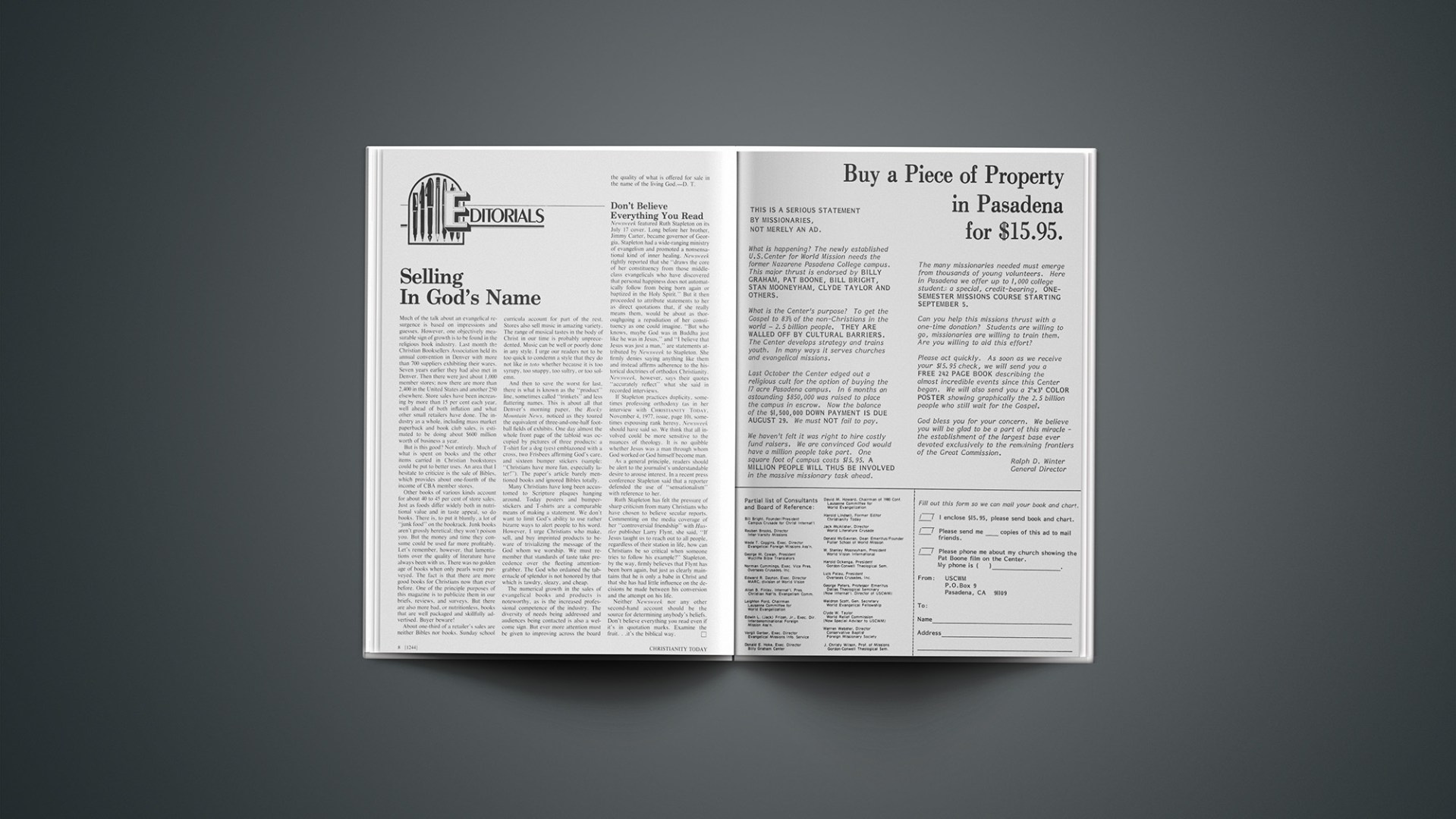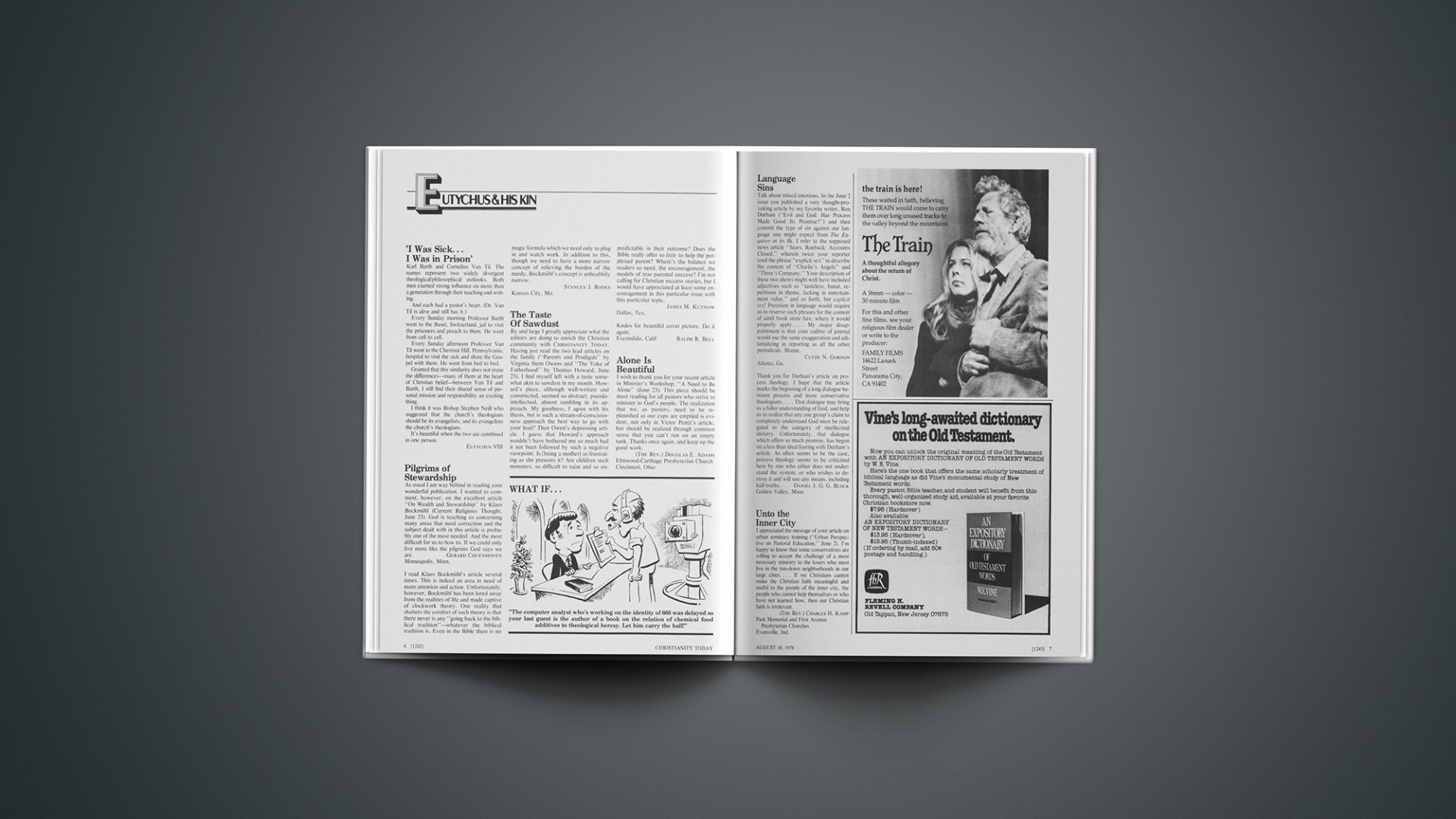Thousands of despairing Christian believers in the Soviet Union see no future for themselves in their beloved homeland, and now they want out. The ranks of Christians seeking emigration visas are swelling weekly. At least 20,000 Pentecostals want to leave, according to the highly respected Keston College Center for the Study of Religion and Communism in suburban London, and the movement is spreading among congregations, both registered and unregistered. Also, an increasing number of Baptists want to emigrate. For the first time, reports Keston, the Council of Baptist Prisoners’ Relatives has come out in support of those who wish to emigrate on religious grounds. In one of its recent secretly published bulletins, the council published an open letter to Communist Party leader Leonid Brezhnev demanding freedom to emigrate for all those wishing to do so because of religious persecution.
Few are granted exit visas, however.
On June 27, seven members of two Pentecostal families from Chernogorsk in Siberia rushed past a police guard in Moscow and barricaded themselves inside the consular lobby of the U.S. embassy. An eighth person, the teen-age son of demonstrators Pyotr and Augusta Vashchenko, was seized by police. The Vashchenkos learned later that he had been permitted to return home.
The Pentecostals announced that they would not leave the embassy until the Soviet Union granted them emigration visas. Early this month they were still there. It was the longest sit-in in the Soviet capital in memory.
In addition to Pyotr Vashchenko. 57, and his wife were three of their thirteen children, Lidiya, 27, Lubov. 25, and Liliya, 21, along with a neighbor, Maria Chmykalova, 56, and her son Timofey, 16.
By day, reported Seth Mydans of the Associated Press, the seven sit on yellow leather armchairs in the consular lobby, quietly reading their Bibles. When the office has closed and everyone has left, they kneel and pray for exit visas so they can go to America to practice their faith. Then they stretch out for the night on sofas in the office. Someone has donated blankets for their use. Embassy staffers take up collections to feed them.
Embassy sources said the seven would not be ejected, despite the protests of Soviet authorities. Every day, though, the embassy asks them to leave, the Pentecostals told Mydans. An American official told them that it is not in their best interest to remain and that chances of gaining a Soviet guarantee of visas are slim. But that is as far as the embassy will go, he assured. “If it is necessary to keep them here forever, then we will,” he said.
The Vashchenkos, a mining family, were among thirty-two persons from their congregation who staged a similar demonstration at the American embassy in 1968. On that occasion, after Soviet officials gave assurances that there would be no retaliation, the embassy staff forced the Pentecostals to leave. The group had been there only four hours. Keston College says that documents from the group show that no reprisals were taken against participants. The Vashchenkos, however, informed reporter Mydans that they spent a term in a labor camp as a result of the action.
Mrs. Vashchenko charged that three of the couple’s children were taken away from them for six years because the government disapproved of the religious atmosphere of their home. (Under Soviet law, children may be taken from parents who are judged unfit to raise good citizens. A number of Pentecostal families throughout Siberia reportedly have suffered under the statute.)
If the Vashchenkos are permitted to leave the country, they may find American sponsors already prepared to take them in. Several years ago the Tolstoy Foundation of New York City lined up sponsors and began sending invitations to some 200 Pentecostals in the Soviet Union who wished to emigrate. The organization also petitioned the Soviet government. So far, only two families have arrived. Tolstoy executive Alla Ivask acknowledged that things “are moving very, very slowly.”
Among the Soviet believers who wish to emigrate is well-known religious dissident Georgi Vins, the leader of unregistered Baptists who is serving a sentence in Yakutia, a labor camp in Siberia. Earlier this year, according to information received by Keston College, he was visited by his son Peter, who brought word that the family had received invitations from relatives in Canada to emigrate to that country. The elder Vins reportedly informed his son in a written statement “certified” by the labor camp administration that he is ready to leave the Soviet Union and live with the Canadian relatives. Until recently, the Vinses and other Baptist leaders believed that the best policy was to stay as witnesses, despite the persecution. Peter Vins’s first arrest for his faith came less than a year ago. His father has spent most of his adult life in confinement or exile. Broken in health, the elder Vins may feel that a new beginning elsewhere is at last in order, say some observers.
One week after Peter Vins returned from the visit, says Keston. he was arrested a second time and sentenced to one year in a Ukranian labor camp for “parasitism,” a charge used often against church workers who have no secular job. Although he was allegedly beaten by a prison guard upon his arrival, the younger Vins is “in good spirits,” a family member reported.
Pastor Charles A. Trentham of First Baptist Church in Washington, D.C., recently traveled to the Soviet Union. While there he visited with dissident Baptists. He declined to comment, however, on what they talked about or on negotiations aimed at the release of Georgi Vins. Trentham, President Carter’s pastor, said the only message he carried from Carter was a greeting to his fellow believers throughout the Soviet Union.
While Pentecostals sat in at the American embassy in Moscow, a different kind of demonstration took place at the Soviet embassy in Washington. High-level representatives of the U.S. Catholic Conference, the Synagogue Council of America, and the National Council of Churches sent ajoint letter of protest to Soviet ambassador Anatoly Dobrynin. The letter protested the recent widely publicized trials of four prominent Soviet dissidents, along with the heavy sentences that were meted out.
The delegation that carried the letter was unable to see Dobrynin, and a press attache refused to accept the letter. The group decided to mail it instead.
Graham: The News Can Be Misleading
Is evangelist Billy Graham a victim of irresponsible journalism, or is it all a case of faulty communication?
The question was raised afresh following the publication last month of a story by reporter Robert Hodierne in the Charlotte Observer. The story, which was widely reported elsewhere, recounts details of financial transactions connected with the 1973 acquisition of a choice 1,050-acre site east of Asheville, North Carolina, for a laymen’s Bible training center. Its cost was $2.75 million. (Additional acquisitions have increased the area involved to 1,374 acres at a total cost of more than $3 million.)
Funds for the purchase came from the World Evangelism and Christian Education Fund (WECEF), the Dallas-based Graham foundation that is also funding the Billy Graham graduate school and archives facility at Wheaton College. Construction of the North Carolina training center, which Graham describes as “the last goal I have before the Lord takes me to heaven,” is expected to begin next year.
Hodierne’s story suggests that it may have been improper for WECEF to purchase the mountain land next to Interstate 40 without an appraisal—a point disputed by some real estate people, including investor Melvin Graham, the evangelist’s brother. He said: “You pay what the man’s asking.… If he sets the price, you’re going to pay his price, or you don’t get the property.” Considering the property’s location and its adaptability to the intended use, the price was a fair one and maybe even a bargain, say some experts. Whatever, it is worth much more today, says an Asheville real estate broker who was involved in the transaction.
Apparently what aroused Hodierne’s curiosity most was the discovery that the $2.75 million price included $650,000 for an option held by two investors. The pair, William Pharr of Pharr Yarns and McLain Hall, a South Carolina real estate broker, had paid only $25,000 for the option just three months earlier, said the reporter. (The option gave its owners the right to buy the land for $2.1 million by mid-1974; no one else could buy it before then without also purchasing the option.)
Further, said Hodierne, some of Graham’s relatives and associates had business dealings in 1973 with the two men, especially with Hall. And it was Hall, he said, who had showed Melvin Graham—a WECEF board member with whom he was linked in several joint real estate ventures—the land that WECEF eventually bought.
Casual readers of the story could have mistakenly inferred that Graham’s relatives and associates somehow profited from the WECEF purchase. Indeed, using a hypothetical case of such self dealing, Hodierne explored the possibility of action by the Internal Revenue Service—thus increasing the likelihood of confusion among readers.
For the second time in a year, Graham took the unusual (for him) step of responding directly to a critical newspaper article. He had said last year that stories on WECEF by Hodierne were “grossly misleading” (see July 29, 1977, issue, page 36, and August 26, 1977, issue, page 18). The latest account, he declared, was “filled with unsupported and untrue innuendos and insinuations.” He added: “To my knowledge, no member of my family or organization has made a cent on the purchase.” An IRS audit of WECEF “took no exception” to the transaction, he said. (Graham declined to be interviewed until after the story was published. Hodierne spoke with several of Graham’s associates instead.)
In a follow-up report, the Observer insisted that its story “did not say Graham family members profited from the sale,” but it kept the pot boiling by implying that Graham was not telling everything he knew.
On the day that the disputed story was published in the Observer, an article on the proposed training center also appeared in the Asheville Citizen-Times, presenting an altogether different perspective. It was written by columnist Bob Terrell, who has often broken Graham announcements in exclusive stories. In it, Graham told of his plans for the center, where lay people “of all ages” can come for two weeks or for longer periods to study the Bible, speech, church history, and the like. A curriculum has been planned tentatively by Charles Riggs, veteran trainer of crusade counselors, who “will probably run the school.” It will “not be an academic institution,” and no credits will be offered, said Graham. Probably only one or two permanent faculty members will be named, he surmised, with others coming from around the world to teach for short periods. Initially, the center will be limited to a maximum of 500 students at a time.
Poetic Justice
Thomas E. F. McNamara, 42, a former educator in the field of fine arts, is considered an expert on the work of American poet Robert Frost. He is apparently less skilled in matters of handwriting, though. Last month he pleaded guilty in a federal court in New Hampshire to charges involving forgeries purported to be manuscripts of Frost and other major poets.
Among the poems McNamara was accused of forging is a two-liner by Frost:
“Forgive, O Lord, my little jokes on Thee,
“And I’ll forgive thy great big one on me.”
Graham, who lives a few miles away in Montreat, said that he intends to keep on preaching. The school “will have to be run by other people,” he acknowledged, “but I will keep my hand in it.” Meanwhile, he added, he will help raise money to build it.
Graham indicated to Terrell that he is not a stranger to criticism over land acquisition. He recalled that his organization in 1953 bought a Colorado property called Glen Eyrie for $300,000 from a Texas oilman who was chairman of the University of Notre Dame board. The idea was to build a Bible school there, said the evangelist, but the board chairman “was a Catholic, and Southern Baptists, who thought I was going to start a new denomination, raised so much fuss that we finally gave the property to the Navigators.”
Test-Tube Results
The birth of the first so-called test-tube baby in England was accompanied by an outpouring of published opinion. Much of the attention, it seemed, was prompted more by intense fascination than by philosophical anguish.
“Used responsibly,” said physician John Dawson, secretary of the British Medical Association’s ethics committee, the technique of laboratory fertilization of a human ovum and reimplantation in the uterus “offers no ethical difficulties for doctors.” He called it “a valuable addition to the treatment for infertile women.”
United States health officials are much more cautious, calling for more research in the laboratory and in animals. They said they will continue a three-year-old moratorium on funding of any studies involving even the first step of combining human ova and sperm until a new National Ethics Advisory Board gives its approval. Although suggested in 1975, the board was not formed until last fall when Secretary Joseph A. Califano, Jr., of the Department of Health, Education, and Welfare began appointing its fourteen members (twelve have been named so far).
“This is the first project we’re going to undertake,” said one of the appointees, cleric Richard McCormick, professor of biological ethics at Georgetown University, a Catholic school. “I have real serious questions and problems that lead me to take a negative position” on the issue “at this time.” There may be doubts, he said, about whether that mere speck-sized clump of cells is or is not “fully a human being. And when there is a doubt, I want to go very slowly and cautiously.”
In any case, as Doctor Luigi Mastroianni, head of obstetrics and gynecology at the University of Pennsylvania Hospital, points out, the procedure pioneered in England relies on hormones to prepare the womb and help maintain the pregnancies. “Our Food and Drug Administration would never allow” use of these hormones, Mastroianni said, “because of the risk of producing congenital abnormalities” or problems in the test-tube children’s future offspring.
Responses of religious spokesmen to the event covered a wide spectrum.
Jewish rabbis were among the least bothered. Rabbi Wolfe Kelman, executive vice-president of the Rabbinical Council of America, the major Orthodox group, pointed out that the first of 613 commandments in the Torah is “be fruitful and multiply.” Therefore, he said, Judaism “is quite lenient in that area.”
Protestant spokesmen tended to take a more guarded stance.
Theologian William Lazareth of the Lutheran Church in America’s Department of Church and Society, commented: “Christian ethics cannot be determined by medical technology. Fallopian tubes, as the Sabbath, are here for the benefit of moral human beings created in God’s image. The basic issue is the validity of conception control, whether in aiding or in preventing such conception.”
According to Lazareth, “the ethical significance of the use of any medically sound method within a covenant of marital fidelity depends chiefly on the motivation of the users.” He pointed out that “human beings do not actually create life, whether inside or outside of test tubes. Ultimately, God remains the sole creator of the egg or the sperm, and the sovereign author of the miracle of life.”
Chairman Haddon W. Robinson of the Department of Pastoral Missions at Dallas Seminary saw “no theological problem” with the English baby, but he said that he was afraid laboratory-fertilized eggs could be placed in “surrogate mothers.” This would raise questions about “what it actually means to mother a child.”
Doctor C. Everett Koop, surgeon-inchief at Children’s Hospital in Philadelphia, who is a Presbyterian elder and an author on bioethics, praised the “remarkable scientific achievement.” But he added, “Since I believe that life begins at conception, I must ask what happens if somebody wants to cancel the experiment and he dumps it down the sink?”
Koop said that he was concerned about “the next step, when Mrs. Jones decides she wants a child from that tall blond gene pool down the block.” He also expressed concern that “some women’s liberation groups” might see it as an advance toward single parenthood, while he is inclined to view it as “just another threat to the family.” He also said that he fears genetic manipulation to produce a “super race.”
Catholics take the dimmest view of developments.
“The episode points to a readiness to implement new technology before its moral implications have been thoroughly considered,” said Bishop Thomas C. Kelly, general secretary of the National Conference of Catholic Bishops. “The consequences of this mentality—from the atomic bomb to uncontrolled use of carcinogenic pesticides—have become clear in recent years. We should proceed cautiously when the same mentality manifests itself in regard to so sensitive and sacred a matter as the transmission of human life.”
Theologian Charles Curran of Catholic University in Washington goes farther: “You have no right to use the process until you have the assurance that it is as safe as normal reproduction.”
“That argument,” counters cleric John Fletcher, a clinical assistant of bioethics at the National Institute of Health, “is an argument against doing anything for the first time.”
Director James McHugh of the Catholic bishops’ Pro-Life Committee maintained that priests should advise against anything that “would tend to mechanize the marriage act.” He added: “It is not necessary to have a child. People can have a certain confidence and reliance on God’s will. If God’s creative act doesn’t take place, it is not to be.”
The Pope had not yet spoken on the topic as of early this month but was expected to voice opposition to any artificial methods that do not aid the natural act. “In the case of the Brown couple,” wrote veteran Vatican journalist Benny Lai in the Florence daily La Nazione, “… sexual relations were missing, and thus the birth of Louise must be taken to be morally illicit.”
Some secular commentators ranged further afield. “Aren’t the more crucial problems of the world those of fertility, not infertility?” wondered Ellen Goodman in the Washington Post.
And syndicated columnist George Will reflected on what he described as a melancholy situation. Said he: “Dangerous and ethically dubious baby-making technologies” are being developed largely for the “compassionate purpose” of helping couples with problems to enjoy parenthood. Adoption, he suggested, would be a better option, but there are few children available for adoption. He concluded: “If there were fewer abortions there would be more adoptions and less pressure [to push] baby-making technologies beyond the range of ethical understanding.”
A Quiet Time For Lutherans
Lutheran church gatherings aren’t always noted for tranquility. But delegates to the Lutheran Church in America (LCA) convention last month in Chicago managed to remain unruffled in electing a new president and passing a variety of potentially controversial resolutions and social statements.
Outgoing president Robert J. Marshall described the ninth biennial meeting as the “easiest” of his ten-year tenure, mainly because of “an evident good feeling among the delegates” gathered at the Conrad Hilton Hotel. Marshall had announced in March that he would step down to become missions and development director of Lutheran World Ministries, a New York-based cooperative agency serving the LCA, the American Lutheran Church, and the Association of Evangelical Lutheran Churches.
Elected to a four-year term as LCA president—the 3.1-million-member denomination’s top executive post—was clergyman James R. Crumley, Jr., 53, who served as LCA secretary for the past four years. He is expected to follow Marshall’s path in emphasizing Lutheran unity and budgetary growth.
Crumley’s twenty years experience as a parish pastor was credited by many for tipping the election in his favor. He narrowly defeated William H. Lazareth, regarded as the LCA’s top theologian, on the sixth ballot. Despite the close vote, though, the election was peaceful.
Formed, in 1962 as a merger of four Lutheran bodies, the LCA is generally regarded as the most liberal of Lutheran groups—though the theological conservatism displayed at the convention might temper that assumption for some. The LCA is slightly larger than other members of Lutheranism’s Big Three: the more conservative 2.9-million-member Lutheran Church-Missouri Synod (LCMS) and the 2.4-million-member American Lutheran Church (ALC), often described as the “moderate” group between the LCA on its left and the LCMS on its right.
Smaller Lutheran bodies include: the Association of Evangelical Lutheran Churches (AELC), a 112,000-member group that broke from the LCMS in 1976 following years of doctrinal controversy; the Wisconsin Evangelical Lutheran Synod (WELS), with about 400,000 members; and the Evangelical Lutheran Church of Canada (ELCC), with 82,000 members.
Reaffirming their commitment to Lutheran ecumenism, the LCA delegates set the gears in motion for a joint consultation of ALC, AELC, and LCA representatives in the fall of 1979. Possible merger will be the main topic of discussion.
In brief fraternal greetings, presidents David W. Preus of the ALC and William Kohn of the AELC praised the signs of increasing cooperation. Following the remarks of Kohn, formerly a missions executive with the LCMS, Marshall told the assembly that overtures between the LCA and AELC are not designed to encourage schism or divisions. However, in an obvious slap at the LCMS, he said that a time may come “when the true confession becomes so obstructed that faithful people in good conscience feel that they must separate themselves from others.”
The LCMS participated in a Lutheran unity consultation from 1970 until 1975, at which time the presidents of the three big churches decided no further progress could be made, mostly because of doctrinal issues raised by the LCMS. It is unlikely that the LCMS will enter any new talks in the forseeable future.
LCMS president J. A. O. Preus did deliver fraternal remarks at the convention. He lauded the LCA for its consideration of “timely concerns,” and he commended Marshall’s work as a “church administrator … who does his homework.” In return, he was greeted with warm applause. Only two years earlier, Preus had jolted the LCA convention with a sharply worded defense against a 1974 LCA resolution that chided the LCMS for “fencing God’s word and fracturing God’s people.”
President S. T. Jacobsen of the ELCC said that the ELCC will pursue efforts to merge Canada’s 300,000 Lutherans within a single Lutheran denomination. About 70 per cent of Canada’s Lutherans belong to U.S.-based denominations, including the LCA and LCMS. An ELCC resolution calls for merger with the LCA-Canada section by 1980.
In other actions, the delegates:
• adopted a social statement on “Aging and the Older Adult” and one on human rights as foundations for action, along with a series of resolutions to implement them (a study of LCA retirement policies, an appeal for help for refugees, and the like);
• approved change of “president” to “bishop” in LCA titles, a switch that must also be endorsed at the 1980 convention in order for it to take effect;
• approved a revised communion practices statement drawn up jointly with the ALC (it precludes infants from receiving communion);
• elected Edgar R. Trexler, Jr., to succeed Albert P. Stauderman as editor of The Lutheran;
• Adopted budgets of $47.2 million and $50.3 million for 1979 and 1980;
• Referred resolutions on homosexuality to LCA units for further study;
• Reaffirmed the 1970 LCA position on abortion, specifying that abortion-on-demand is not endorsed;
• went on record opposing pending legislation in congress that would require certain disclosures by church and other lobby groups.
At the convention’s opening session, two delegates protested the church’s choice of Illinois as a convention site. The state, they pointed out, had not voted to ratify the Equal Rights Amendment. One-fourth of the delegates submitted their signatures to indicate that they were seated under protest.
From then on, though, the mood was as placid as the warm Lake Michigan waters a short stroll away.
JOHN MAUST
Anglicans: Marriage Issues
Following nearly five hours of debate, the General Synod of the Church of England last month voted 367 to 92 to endorse a controversial ecumenical document known as the Ten Propositions. The paper, published in 1976 by a commission representing most of the nation’s denominations, asks those denominations to join in a covenant to seek visible unity and to press for action on intercommunion, agreement on baptism, and mutual recognition of ministries (see February 13, 1976, issue, page 74).
Archbishop of Canterbury Donald Coggan intervened during the debate to calm the strong Anglo-Catholic (or “high church”) faction, which feared a setback in relationships with the Roman Catholic Church. This faction hopes for eventual Anglican reunion with Rome. With Coggan’s assurances plus certain stipulated conditions, many of the Anglo-Catholics voted their approval. The conditions include the acceptance by the other churches of the historic episcopate at the inauguration of the covenant, and a narrowly passed amendment made clear that this must involve the consecration of bishops. Further, according to the conditions, the mutual recognition of ministers among the covenant groups must be effected “by the action of the whole episcopate of all the covenanting churches.” Other elements of Anglican tradition and practice were included in the clergy section of the conditions.
The action by the synod affected Britain’s Methodist Conference, which voted in June to endorse the propositions—on the condition that the Anglicans would do likewise. Earlier, the Moravian Church and the United Reformed Church approved, and endorsement by the Churches of Christ was expected this month. So far, the Catholic Church, the Congregational Federation, and the Baptists have decided against joining the covenant.
The next major step in the unity timetable will be the composition of a draft covenant by the unity commission. It is scheduled to be released for discussion among the approving denominations in 1980. The conditions that will be laid down in advance by the Anglican negotiators, however, may be a higher price for unity than the other churches are willing to pay. Marriage is still a long way off, say observers.
In addition to its action on unity, the synod voted 213 to 206 not to change long-standing rules that bar the remarriage in church of a divorced person while the other partner is still alive. Coggan made it clear that he was against relaxing the rules but said that he wished he could find some way out of the dilemma. (A study last year indicated that a large majority of Britain’s Anglican priests favor relaxation of the rule, a marriage-study commission of the church expressed a similar view, and an increasing number of remarriages are being conducted by parish priests in defiance of policy.)
“It’s a matter of some agony to me to have to register my own decision against this,” commented Coggan. “But I ask myself whether this is the moment for the church to take off the brake, perhaps the last brake, and rush down the divorce slope.”
Peaceful Prague
“… Christians for peace, justice, and liberation,” proclaimed the theme of the fifth assembly of the Christian Peace Conference (CPC), which met in Prague in June. In a sense, the CPC itself was enjoying a measure of liberation.
The CPC was founded twenty years ago by the late Czech Brethren leader Joseph L. Hromadka, mainly as a forum for churches in Soviet-bloc nations. It also attracted some participants from the West. But after the Soviet invasion of Czechoslovakia in 1968, a Soviet-dominated faction took over the Prague-based conference, and Hromadka resigned in protest. Consequently, at the last assembly—held in 1971—no Americans and few from the West attended.
This year was different. Twenty-four Americans attended, most of them from a National Council of Churches unit, and three were elected to important CPC offices.
Bishop Karoly Toth of the Reformed Church of Hungary was elected CPC president, succeeding Metropolitan Nikodim of the Russian Orthodox Church. Toth was elevated to the presidency from the general secretary slot.
Ludomir Mirejovsky was elected general secretary by the conference’s continuation committee from a field of six candidates—all of them Czech. The conference’s international secretariat excluded consideration of other nationalities. Mirejovsky, a clergyman of the Evangelical Church of Czech Brethren who attended Union Seminary (Presbyterian) in Richmond, Virginia, had been ousted from the CPC’s international commissions following Hromadka’s resignation and was not permitted to participate in them until this assembly.
Hromadka was also rehabilitated in a sense. His widow was an honored guest and gave an address to the women of the assembly. A booklet about her husband was given to the delegates.
Soviet interest in the assembly was still very much in evidence, however. An estimated 300 delegates and their spouses (out of a total of more than 600 participants from eighty-four countries) came from the Third World, with the Russian Orthodox Church reportedly paying their airfare. They were flown to Moscow, and four chartered Aeroflot planes ferried them to Prague and back. (In the past, CPC statements consistently have reflected Soviet policy and often have been outwardly critical of the West.)
In a message to churches, the assembly declared that “solidarity in the work for peace means joining the fight for liberation.” It singled out racist oppression in southern Africa, military dictatorships in Latin America, and other “pockets of colonialism” in the non-Communist world. It appealed for support of detente and for achievement of general and complete disarmament by the year 2000.

